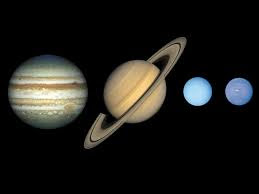#10 Fascinating Facts About the Kuiper Belt :
 |
NASA’s New Horizons spacecraft captured this high-resolution enhanced color view of Pluto, which resides in the Kuiper Belt, in 2015.NASA/JHUAPL/SwRI |
The Kuiper Belt is a vast, enigmatic region that stretches beyond Neptune, shrouded in cold darkness and holding crucial clues to the origins of our solar system. Here are 10 essential facts about this intriguing part of our cosmic neighborhood:
## 1. A Vast Expanse Beyond Neptune:
The Kuiper Belt is one of the solar system's largest structures, alongside the Oort Cloud, the heliosphere, and Jupiter's magnetosphere. Shaped like a puffed-up disk or donut, its inner edge begins at Neptune's orbit, about 30 AU from the Sun (1 AU being the distance from Earth to the Sun). The main region extends up to 50 AU, beyond which lies the scattered disk, reaching nearly 1,000 AU and containing objects on even farther orbits.
## 2. Far Out but Not the Farthest:
While the Kuiper Belt is an outer region of our solar system, it shouldn't be confused with the Oort Cloud, which is even more distant. Both regions are believed to be sources of comets, but the Oort Cloud is a spherical shell that encases the entire solar system, including the Kuiper Belt.
## 3. Similarities to the Asteroid Belt:
 |
This artist's illustration shows Dwarf Planet Eris and its moon Dysnomia in the Kuiper Belt. The rest of the solar system appears as a distant, dusty disk.NASA/ESA/STScI |
## 4. A Small Fraction Discovered:
 |
The orbits of all four giant planets of our solar system may have shifted early on, creating the Kuiper Belt while also ejecting lots of other icy objects.NASA/JPL-Caltech |
## 5. Once Richer in Material:
 |
An arrow on this Hubble Space Telescope image points to the moon that orbits Kuiper Belt Object (and dwarf planet) MakeMake.NASA, ESA, and A. Parker and M. Buie (SwRI) |
These fascinating facts only scratch the surface of what the Kuiper Belt holds, hinting at the immense, unexplored mysteries that await us in this distant region of space.
## 6. Many Kuiper Belt Objects Have Moons:
A significant number of Kuiper Belt Objects (KBOs) are accompanied by moons, or they exist as binary systems. Binaries are pairs of objects that are similar in size and orbit a common center of mass. Some binaries even touch, forming a "contact binary" with a peanut-like shape. Notable KBOs with moons include Pluto, Eris, Haumea, and Quaoar.
## 7. The Kuiper Belt: A Comet Factory:
## 7. The Kuiper Belt: A Comet Factory:
 |
Astronomer Gerard Kuiper, for whom the Kuiper Belt is named.University of Arizona Lunar and Planetary Laboratory |
## 8. Named After but Not Discovered by Kuiper:
 |
These images show the first known Kuiper Belt Object, 1992 QB1 (or Albion, circled), which was discovered in 1992 by American astronomers David Jewitt and Janet Luu.European Southern Observatory |
## 9. Pluto: The First Unrecognized KBO:
Pluto, discovered in 1930, was the first KBO. At the time, astronomers did not expect a large population of icy worlds beyond Neptune, so Pluto was initially classified as a lone planet despite its unusual orbit. It took until 1992 for the second KBO to be discovered, leading to the realization that Pluto was just one of many objects in the Kuiper Belt.
## 10. Pioneer to New Horizons: Exploring the Kuiper Belt:
## 10. Pioneer to New Horizons: Exploring the Kuiper Belt:
 |
This view of Arrokoth was obtained by NASA's New Horizons spacecraft as it flew by the object on Jan. 1, 2019 |
NASA's Pioneer 10 was the first spacecraft to enter the Kuiper Belt region in 1983, but it did not visit any KBOs.The first mission to explore a KBO was NASA’s New Horizons, which flew by Pluto and its moons in July 2015 and later visited Arrokoth on January 1, 2019. Arrokoth, with its unique double-lobed, snowman-like shape, offered a surprising and fascinating glimpse into the Kuiper Belt's diversity.
These facts highlight the Kuiper Belt's critical role in understanding the history and formation of our solar system, emphasizing the need for continued exploration and study.
These facts highlight the Kuiper Belt's critical role in understanding the history and formation of our solar system, emphasizing the need for continued exploration and study.













